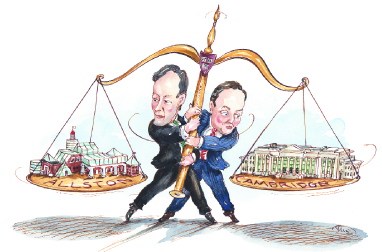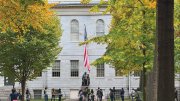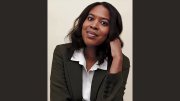Harvard Law School (HLS) is carefully weighing the pros and cons of building a new campus for itself in Allston. A "locational options" committee of seven faculty members and one administrator is considering all the factors that could affect such a decision. The committee's chair, professor of law Elena Kagan, said in December, "We are still early on in our discussions and fact-finding," but noted that the group's aim was to finish its work by the end of the academic year. "We will not be making a recommendation," she said, but will instead "develop arguments" for and against a move to Allston.
Two and a half years ago, the school's faculty voted overwhelmingly against such a relocation. But since that time, HLS has completed a strategic plan outlining academic priorities that include expanding the faculty and transforming the student experience--moves that will require substantial new space (see "The Law School Looks Ahead," September-October 2001, page 64). Dean Robert C. Clark presented the plan to the Harvard Corporation in November 2000, along with a strategy for accommodating most, if not all, of the school's physical growth in Cambridge.
"Our immediate space needs," he said then, are "extremely pressing"--on the order of 114,000 gross square feet, by one estimate. A restructuring of the first-year class into smaller sections, each organized as a "law college," and plans to hire 15 additional faculty members would generate the need for even more space, he said. By redeveloping an area between Pound Hall and Everett Street, the school could gain almost 238,000 square feet. "We projected the plan would take care of our needs for 20 years, but perhaps just for 10, by a short estimate," Clark said in a recent interview. "What would happen after that time? Probably a lot of trouble." That is one of the arguments for Allston, he notes. "It gives you more like a 100- or even 200-year time horizon, rather than a couple of decades."
 |
| Illustration by Mark Steele |
President Lawrence H. Summers spoke to the school's faculty last fall about the importance of Allston to the University as a whole. "The Corporation has made it clear that the decisions on future physical planning are going to be made on a University-wide basis, recognizing the interests of each of the schools and [all] the possibilities that might unfold," Summers said in an interview. "So I have discussed with the law school faculty, in the context of their strategic plan and plans for expansion, how important it is for them to recognize, alongside anything they want to do in Cambridge, the possibility of a number of different configurations down the road in Allston. One is allowing the law school the enormous intellectual advantage of a new campus, configured to reflect not historical accumulation, but what is most desirable for contemporary academic life. Allston is an enormous opportunity," he reiterated. "We are the only urban university in the United States with the capacity for substantial academic expansion. That creates potentially important intellectual opportunities and a great capacity to strengthen the entire University."
Clark has been speaking to HLS alumni about the possibility of an Allston move, and says that "preliminary soundings are pretty encouraging--most are fairly pragmatic about it and think that the pros and cons of a move should be explored carefully. While there are some who feel very nostalgic, they are a distinct minority."
Kagan's committee will look at a host of issues surrounding the school's future needs. "The strategic-planning committee did a great job figuring out how to grow on this campus," she says. Now her group will "assess the alternatives." Beyond looking at specific sites and exploring the financial implications of a move, the committee is asking questions about what makes the law school attractive to students and faculty in terms of recruitment and how that attractiveness can be enhanced. Kagan cites needs for student organization space, for social spaces, and for better athletic facilities. Improving the faculty-to-student ratio, she notes, will create its own space pressures. She does not believe that faculty sentiment with respect to Allston has changed much, citing the "attachment that the Law School faculty has for this place, for many good reasons," but says that faculty members "recognize a need to step back and consider this and to be as objective as possible."
The work of Kagan's group will parallel that being undertaken by a University physical-planning committee chaired by Dennis F. Thompson, professor of political philosophy and senior adviser to the President. Thompson chaired a similar committee under former president Neil L. Rudenstine, and has been tapped to continue the work of strategic physical planning in Allston and Cambridge under Summers. The new committee, he says, has fewer administrators, more faculty, and includes Peter Rowe, dean of the Graduate School of Design. "The purpose of some of these membership changes," says Thompson, "is to focus more on academic priorities. And because we must consult closely with community groups, vice president for government and community affairs Alan Stone" is also part of the committee, as is Kagan, to facilitate coordination with the law school.
Thompson's group is examining three models for the Allston land. One is an academic campus that would involve several professional schools, the law school being one--"but we haven't ruled anything out," says Thompson. "A second would be a science park or science campus," housing scientists from the School of Public Health and the Faculty of Arts and Sciences. The third option would be a mixture of museums, housing, and administrative support; "not the most exciting alternative," says Thompson, "but it needs to be considered."
Consultants will help the University committee answer a series of questions about the three models. First, what are the "opportunity benefits" in Cambridge of the various scenarios? "The objective is not just to make a beautiful campus in Allston," says Thompson. "It is to help make the Cambridge campus better than it is now for those who remain." A second goal will be to clarify the academic benefits of each option. "Why might it be intellectually productive for the law school, the business school and the Kennedy School to be closer together? What would be the academic benefits," Thompson asks, "of relocating scientific research in Allston?"
One of the greatest challenges, he says, is thinking about development as a phased process. "Even if we knew today that 20 years from now there would be a campus bringing all of the major professional schools together, that wouldn't answer the question of what we should do two years from now, or five years from now," says Thompson. "If we begin by moving museums and building housing, we want to make sure that we don't put those structures in places that would make an academic campus less desirable. The challenge is to make decisions about each of the stages on the way to the end state when we don't know what the end state is."
Thompson hopes to have the consultants' reports in a year, but says that it will be "two years at best before we will have an answer to the question of who, if anyone, will move."
Says the law school's Clark, "This is a University-wide issue that will be decided with everything in view, with all of the pros and cons, for the the good of the whole. I don't think it is right for any school to have a veto, but I am very optimistic that we will reach a good decision." And who will ultimately decide? Says Summers, "Any decision so fundamental will have to be made by the Harvard Corporation."





